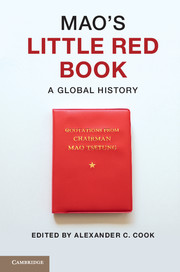Book contents
- Frontmatter
- Contents
- List of illustrations
- List of contributors
- Preface
- 1 Introduction
- 2 A single spark
- 3 Quotation songs
- 4 Mao quotations in factional battles and their afterlives
- 5 Translation and internationalism
- 6 Maoism in Tanzania
- 7 Empty symbol
- 8 The influence of Maoism in Peru
- 9 The book that bombed
- 10 Mao and the Albanians
- 11 Partisan legacies and anti-imperialist ambitions
- 12 Badge books and brand books
- 13 Principally contradiction
- 14 By the book
- 15 Conclusion
- Index
- References
7 - Empty symbol
The Little Red Book in India
Published online by Cambridge University Press: 05 June 2014
- Frontmatter
- Contents
- List of illustrations
- List of contributors
- Preface
- 1 Introduction
- 2 A single spark
- 3 Quotation songs
- 4 Mao quotations in factional battles and their afterlives
- 5 Translation and internationalism
- 6 Maoism in Tanzania
- 7 Empty symbol
- 8 The influence of Maoism in Peru
- 9 The book that bombed
- 10 Mao and the Albanians
- 11 Partisan legacies and anti-imperialist ambitions
- 12 Badge books and brand books
- 13 Principally contradiction
- 14 By the book
- 15 Conclusion
- Index
- References
Summary
The Little Red Book gained popularity in India with the outbreak of the Naxalite Movement, named for the hamlet of Naxalbari (in the Darjeeling district of the eastern Indian state of West Bengal), where in the early summer of 1967 a local communist unit led poor peasants to overthrow the local gentry in a land dispute. This so-called victory of the peasant insurgents was short-lived, but it had significant consequences. It split the communist movement in India for a second time, following the Sino-Soviet split of the mid-1950s, and introduced violent revolutionary Maoism (or Naxalism) into Indian politics. The Indian state considers Naxalism a security threat even today, with twelve of its twenty-eight states under some degree of pressure. However, the first phase of the Naxalite Movement ended with the death of its leader, Charu Majumdar, in 1972, after which the Little Red Book rapidly declined in popularity. As chief leader of the Naxalite Movement, Majumdar treated the Quotations like gospel, insisting in his writings and speeches that his comrades keep a copy of the Little Red Book on their persons at all times, to be studied in indoctrination classes and also read aloud to aid the illiterate peasants in the midst of their “armed struggle.” A good many students and intellectuals recruited to the organization took this directive seriously and did follow it. However, as will be shown later, no other senior functionary of the Naxalites put so much stress on reading the Quotations; in fact, as revealed later, many of them were opposed to reducing the entire Maoist ideology to the short passages in the Little Red Book. Majumdar’s closest comrades believed the Little Red Book to be of little consequence to the movement, and after his demise the importance of the Quotations among the Naxalites faded.
- Type
- Chapter
- Information
- Mao's Little Red BookA Global History, pp. 117 - 129Publisher: Cambridge University PressPrint publication year: 2014
References
- 2
- Cited by

